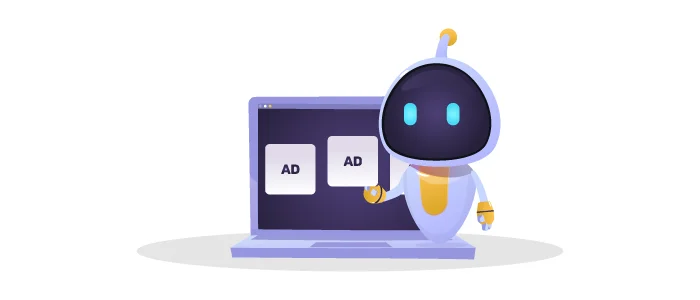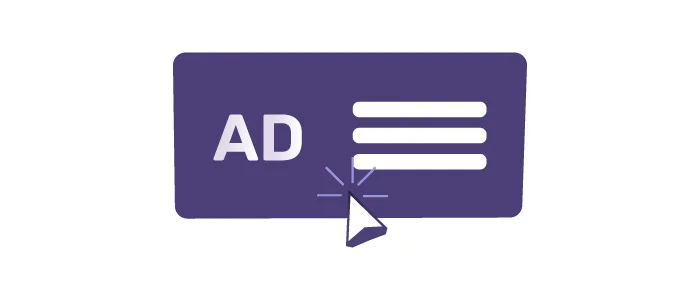What Is Display Advertising: A Simple Guide
We live in a crowded digital world, and grabbing attention is more complex than ever. People are spread across many platforms, which makes it challenging for businesses to connect meaningfully.
That’s where display advertising makes a difference. It’s a powerful way to reach your target audience using eye-catching visuals (banners, videos, and interactive ads) strategically placed across websites, apps, and social media.
In this article, we’ll break it all down in simple terms. You’ll learn what display advertising is, how it works, the different types of display ads, and how to create a campaign that stands out and gets results.
Table of Contents
What is Display Advertising?

Display advertising uses visual elements (e.g., images, videos, and rich media) to promote products, services, or brands on websites, apps, and social media platforms.
These ads appear on display networks and aim to capture user attention through engaging visuals and strategic placements.
Think of it as a smart billboard that knows what you like. One minute, you’re reading a blog about running tips, and the next, boom, there’s an ad for the sneakers you left in your cart last night.
How Does Display Advertising Work?
Display ads are delivered using ad network platforms that connect advertisers (businesses) with publishers (websites or apps that display the ads). Here’s how it works in simple steps:
- Advertiser creates a campaign with visuals, a target audience, and a budget.
- Ad network matches the ad with websites or apps that fit the criteria.
- The ad appears when a user visits a page and matches the target profile.
- Advertiser pays when a user sees (CPM), clicks (CPC), or converts (CPA) from the ad.
For example, Coinzilla is a user-friendly ad network that connects advertisers with the top finance and crypto websites (publishers).
Types of Digital Display Advertising

Display ads come in many shapes and styles, and each type plays a different role in capturing users’ attention. Whether you’re aiming for clicks, brand awareness, or engagement, there’s a display ad format to match your goal. Here’s a closer look at each type:
1. Standard Display Ads
These are the most common types of display ads you’ll see online. They use images, text, and simple animations to grab attention.
- Banner Ads (Static and Animated)
These image-based ads appear on websites, usually at the top, bottom, or side. Static banners use a single image, while animated ones rotate through visuals or messages. They’re great for brand awareness.
- Responsive Ads
These ads automatically adjust their size, appearance, and format to fit different devices and screen sizes. You upload images and text, and the ad network creates the best combinations.
2. Advanced Display Ad Formats
These go beyond simple images and bring your ads to life with interaction and movement.
- Rich Media Ads
Rich media ads include advanced features like video, audio, or interactive elements. Users can hover, swipe, or click for more information, making them highly engaging.
- Interactive Display Ads
These allow users to take action directly within the ad, like taking a quiz, watching a preview, or flipping through product images. They are great for boosting engagement and time spent with your brand.
- Video Display Ads
Short videos can be embedded in articles, uploaded to YouTube, or featured in mobile apps. They’re perfect for storytelling and building a stronger emotional connection with your audience.
3. User Experience Formats
These ads are designed to blend in (or break in) in ways that either feel natural or demand full attention.
- Native Display Ads
Native ads match the look and feel of the content around them, so they don’t feel like ads. They’re less disruptive and tend to get higher engagement.
- Interstitial Ads
Full-screen ads appear during natural transition points, between levels in a game, or while a page loads. They’re bold and hard to miss, but should be used carefully to avoid annoying users.
- Pop-up Ads
These are small windows or overlays that “pop up” on the screen. While they can be effective, they should be used sparingly and with clear exit options to smooth the user experience.
4. Targeting Strategies
Targeting is what makes display advertising so powerful. Instead of showing your ad to everyone, you show it to the right people at the right time.
- Retargeting Display Ads
Have you ever noticed an ad following you around after you visit a website? That’s retargeting. It reminds users about products they showed interest in, nudging them to return and convert.
- Contextual Display Ads
These ads appear on web pages that are relevant to the content of your ad. For example, an ad for hiking boots might appear on an outdoor travel blog.
- Behavioral Display Ads
Behavioral ads are shown based on a user’s past online behavior, such as the websites they visited, searches they made, or products they browsed. It’s like showing your ad to someone already interested.
The Benefits of Display Advertising
Display advertising is more than just eye-catching images; it’s a smart way for businesses to reach the right people at the right time and place. Whether you want to get your brand noticed or increase sales, display ads can help you achieve your goals in a clear, targeted, and measurable way.
| Benefit | What It Means |
|---|---|
| Brand Awareness | It gets your brand in front of more eyes, helping people recognize and remember it. |
| Cost Efficiency | You can start small, control spending, and pay only for actions that matter (views, clicks, or conversions). |
| Wide Reach | Ads can appear globally or locally across millions of websites, apps, and platforms. |
| Visual Storytelling | Use images, videos, and animations to tell your brand’s story engagingly. |
| Precise Targeting | Show your ads to specific audiences based on interests, location, behavior, etc. |
| Retargeting Capabilities | Reconnect with users who visited your site but didn’t take action, boosting conversions. |
| Measurable Results | You can track how your ads perform and how many people see them, click on them, or buy something. With built-in analytics, you can see exactly what’s working and adjust your strategy in real time. |
| Complementary Strategy | Works well with other digital marketing strategies like social media, SEO, and email to boost results. |
How to Set Up a Display Advertising Campaign

You don’t need to be an expert to set up a display advertising campaign. Follow these steps to plan, launch, and manage it from beginning to end.
Define Campaign Objectives
Before you start, think about what you want to achieve with your display ad campaign.
- Do you want more people to know about your brand?
- Are you trying to get more visitors to your website?
- Or maybe your goal is to boost sales or sign-ups?
Knowing your goal from the beginning makes everything easier. It helps you choose the right images, set the proper advertising budget, and track the right results. Your campaign will be more focused, effective, and easier to manage.
Identify Target Audience
To run a display ad campaign, you must know precisely who you want to reach. Start by thinking about basic details like age, gender, and location. Then, what are their interests, hobbies, and online habits? What websites do they visit, and what products do they search for?
The more specific you are about your audience, the easier it is to create ads that speak directly to them and get better results.
Choose the Right Platform
Choosing the right platform is essential to reaching your audience and achieving your campaign goals. If you’re looking for simple, all-in-one solutions, Sevio Ad Manager makes it easy to create, launch, and manage your display campaigns from one place.
Design Effective Creative Assets
Your ad creative is what grabs attention, so make it count. Focus on creating eye-catching visuals that align with your brand’s identity. Use high-quality images or short videos that stand out. Keep your message brief and concise, and ensure everything from layout to font size is easily viewed and read on desktop and mobile devices.
Set Campaign Parameters
Setting the correct parameters to stay on track and within budget is essential before launching your campaign. Start by deciding how much you want to spend, whether a daily limit or a monthly budget. Then, choose the dates your campaign will run so your ads appear at the right time.
Finally, pick a bidding strategy that fits your goals. These settings help you effectively control performance and costs.
Implement Tracking
To see how your ads are performing, set up tracking before your campaign goes live. Use tools (e.g., tracking pixels or conversion tags) to monitor what happens after someone clicks your ad. Do they visit your site, sign up, or make a purchase? This data helps you understand which ads are working and which need tweaking.
You can make smarter decisions and improve your results with the proper tracking.
Launch and Monitor
Once your campaign is ready, hit launch, but don’t just set it and forget it. Monitor key metrics like impressions, clicks, click-through rate (CTR), and conversions closely.
Regularly monitoring your campaign helps you spot what’s working and what isn’t, making it easier to make quick adjustments and stay on track with your goals.
Optimize Continuously
Optimization doesn’t stop once your campaign is running. It’s an ongoing process.
Use the data you collect to fine-tune your strategy. Adjust your targeting to better reach your ideal audience, test different images or messages to see what gets the best response, and pause ads that aren’t delivering results. If you spot a top-performing ad, consider increasing its budget to maximize its impact.
Even small changes can lead to significant improvements over time.
Best Practices for Display Advertising Campaigns
Display advertising continues to grow rapidly, with research estimating that the global digital display advertising market will reach 350 billion by 2033. That clearly shows how important and competitive this space is becoming.

To stand out and make your ads work smarter, not just louder, it’s essential to follow some best practices. Here’s what you should keep in mind:
Maintain Brand Consistency
Make sure your display ads align with your brand’s identity. Consistently use your brand’s colors, logos, fonts, and messaging across all ads so your audience can easily recognize you, no matter where they encounter your ad.
Prioritize Visual Impact
First impressions count. Use high-quality images, vibrant colors, and a clean design to capture attention instantly. A visually appealing ad is far more likely to make someone pause and engage rather than just scroll by.
Include Clear CTAs
Each ad should feature a clear and compelling Call to Action (CTA). Whether it’s “Shop Now,” “Learn More,” or “Sign Up,” ensure users understand exactly what action to take next.
Respect User Experience
Avoid intrusive formats or excessive animations. Ads that cover content, autoplay sound, or feel disruptive can create negative brand associations and may even lead to ad blocking.
Optimize Loading Speed
Large files or slow-loading animations can cause your ad to load too late or not show up at all. To avoid this, compress images, use efficient formats, and test how quickly your ads load on various devices.
Implement Frequency Caps
Nobody wants to see the same ad repeatedly. Limit the number of times your ads are shown to the same person to avoid annoying your audience and wasting your budget.
Monitor Brand Safety
Ensure your ads don’t appear on inappropriate or unsafe websites. Use tools and settings from your ad platform to maintain control over where your brand shows up.
The Future of Display Advertising and Current Trends

As technology advances and user behavior shifts, businesses must stay ahead of the curve. Below are the key trends that are shaping the future of display advertising.
AI and Machine Learning in Display Ads
Artificial Intelligence (AI) and machine learning are changing how display ads are made, targeted, and improved. These innovative tools help advertisers make data-driven decisions that boost results more efficiently. Here’s how they work:
- Smarter targeting: AI can quickly analyze browsing habits, search history, and user preferences. This helps show ads to the right people at the right time.
- Automated ad creation: Many ad platforms now use AI to create multiple ad versions automatically. They mix and match headlines, images, and calls to action to find what performs best.
- Real-time optimization: Machine learning tests different ad versions as they run. The best-performing ads are shown more often without needing manual updates.
Privacy Changes Affecting Display Advertising
Online privacy is a growing concern. In response, users are becoming more cautious, and governments are introducing stricter regulations. One major shift is moving away from third-party cookies, small files that external companies use to track people across different websites. Browsers like Chrome and Safari are phasing them out, meaning advertisers can no longer rely on this data for personalized ads.
At the same time, new privacy laws such as GDPR in Europe and CCPA in California are introducing stricter rules about how companies collect and use personal information.
As a result, businesses are turning to first-party data instead. They collect data directly from their customers, such as email signups, purchase history, and on-site behavior.
FAQ
Digital display ads appear on websites, mobile apps, social media platforms (Facebook and Instagram), and video services (YouTube). Advertisers can reach users through ad networks as they browse the web, watch videos, use apps, or scroll through social media.
Display advertising began in 1994 with the first online banner ad published on HotWired. Since then, display ads have evolved from simple static banners to interactive and video formats, becoming a key part of modern digital marketing strategies.
Display advertising costs vary depending on your goals, targeting, and industry. Ad platforms usually charge for display ads using pricing models such as CPM (cost per thousand impressions) or CPC (cost per click).
To get started with display advertising, you can try tools like Google Ads or Facebook Ads Manager, depending on where you want your ads to run. You can also use a platform like Sevio Ad Manager. It lets you easily upload your ads, set your goals, choose where they appear, and track performance, all in one place.
To measure the success of a display ad campaign, track the following key metrics:
Impressions: How many times was your ad shown?
1. Clicks and Click-Through Rate (CTR): How many users clicked and how often?
2. Conversions: Actions taken after clicking the ad (e.g., purchases or sign-ups).
3. Cost Per Click (CPC) or Cost Per Acquisition (CPA): How much you pay for each result.
5. Return on Ad Spend (ROAS): How much revenue your ads generate.
Final thoughts
If you’ve ever wondered what is display advertising, here’s the simple answer: it’s a powerful way to promote your brand using visuals such as banners, videos, and interactive ads. These ads appear on websites, apps, and social media where your audience spends time.
The best part? You don’t need to be a pro to get started. Set clear goals, know your target, use eye-catching designs, and track your results. Whether you want more clicks, sales, or people to recognize your brand, display advertising can help you achieve your goals.